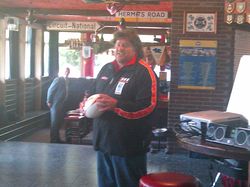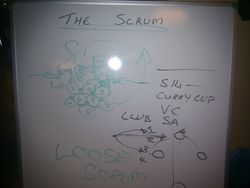These days people keep telling me that I look tired. And I don't just look…
Specialization in (Rugby) Scrums
Yesterday I did a presentation about Scrum for Level Up, a small IT organization in Delft. It was my standard talk, called the Zen of Scrum, which I often use to explain the basics of agile principles and common practices.
What I liked about this particular session was that Level Up had hired the canteen of a rugby club in The Hague. And more than that, they had asked a real professional rugby coach to precede my talk with a 30-minute explanation of scrums in rugby. It was very enlightening!


(sorry about bad quality of pics)
I never knew that in a rugby scrum many of the team players have a specialized role to fulfill. There are props and hookers and locks and flankers… And yes, most players are able to take over the roles of one or two others, but none of them can perform each and every role in the team! It is impossible for a rugby player to be big, heavy and strong and also light, fast and nimble. If a coach tries to form a rugby team where all players can play every single role, then inevitably he ends up with a mediocre team!
I saw a great parallel with software development, and I have discussed before that specialization is great and that it's best to work with generalizing specialists, who specialize in a role, but who are also able to perform some other roles adequately, when the need arises. A generic name like "team member" is fine, but in yesterday's talk I saw confirmed (again) that the greatest teams work with (generalizing) specialists who love nothing more than the role they have agreed to play.
It is a message that I will keep repeating, to myself and others: when you all have the same job title that doesn't mean that you should all carry out the same work.
Oh, and another thing I learned is that rugby scrums are break-neck dangerous. Many players get injured when doing it wrong. Do we see any parallels there with software development as well?
Note: this is the new (3rd) version of The Zen of Scrum, uploaded yesterday. I made some minor changes and improvements. Feel free to download it…
 Twitter –
Twitter –  Subscribe –
Subscribe –  Newsletter –
Newsletter –  LinkedIn –
LinkedIn –  SlideShare
SlideShare
| Latest, greatest and favoritest posts: The Schizophrenia of Scrum Self-Organization vs. Emergence The Optimal Team Size is Five |



